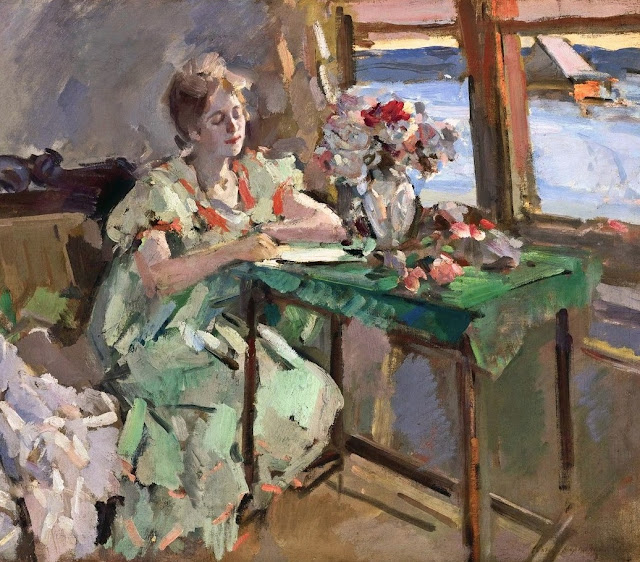Korovin Konstantin [1861-1939]
Muse. 1887
Oil on canvas
The State Tretyakov Gallery
Konstantin Alekseyevich Korovin (5 December 1861 – 11 September 1939) was a leading Russian Impressionist painter.
In 1875 Korovin entered the Moscow School of Painting, Sculpture and Architecture, where he studied with Vasily Perov and Alexei Savrasov. His brother Sergei was already a student at the school. During their student years, the Korovins became friends with fellow students Valentin Serov and Isaac Levitan; Konstantin maintained these friendships throughout his life.
Konstantin Korovin (1861–1939)
Portrait SN Galitzine. 1886
Oil on canvas
Collection of the State Tretyakov Gallery
In 1881–1882, Korovin spent a year at the Imperial Academy of Arts in St. Petersburg, but returned disappointed to the Moscow School of Painting, Sculpture and Architecture. He studied at the school under his new teacher Vasily Polenov until 1886.
Konstantin Korovin (1861–1939)
"Paris Cafe" (second half 1890)
Oil on canvas
The paintings, inspired by Paris, shows Korovin's strong impressionism. A cozy corners Parisian café with vistas of the boulevard. The subtlest tonal gradations of light transmits the smallest details of the effects of: humidity, light fog, light halos sunlight, condensation and rarefied atmosphere. The picture is full of the cheer and happiness, that distinguishes most of the artist's paintings.
Korovin Konstantin [1861-1939]
Spaniard. 1894
Oil on canvas
58 x 33 cm
In 1885 Korovin traveled to Paris and Spain. "Paris was a shock for me … Impressionists… in them I found everything I was scolded for back home in Moscow", he later wrote.
Konstantin Korovin (1861–1939)
"In the balcony. Leonora and Ampara Spanish flu" (1888-1889)
Oil on canvas
Tretyakov Gallery, Moscow, Russia
The painting was begun in 1888 in Valencia, during a trip to Spain, and finished in 1889 in Moscow. To thank the girls posing, Ampara and Leonora, the artist presented them with their favorite shoes and shawls of Chinese silk. In 1889, Korovin made his debut with the "Spanish flu" in the exhibition of the Wanderers, and in 1900 won the gold medal in the framework of the Russian exposition at the World Exhibition in Paris. This contributed to his European and world-famous renown. "Spanish flu" was important because color was an evident attitude for the painter, "warming" tone. Light, moving impressionistic brushstrokes are combined with decorative Art Nouveau. More
In the 1890s Korovin became a member of the Mir iskusstva art group.
Konstantin Korovin (1861–1939)
"Northern Idyll" (1892)
Oil on canvas
State Tretyakov Gallery
The idea for this painting came to Korovin while working on a design for the opera "The Snow Maiden" based on the play by Alexander Ostrovsky. At the time the artist was working in the theater and often turned to the subject of folklore. In the picture are clearly visible innovative techniques Korovin in theatrical decorative art. Strong contrast of bright, saturated colors of the national costumes, combined with dark tones vechereyuschego sky, eclectic detailed landscape images and generalized patches of color figures. This was new to the theater. The painting reflects the poetic relationship between man and nature, it carries the Russian national coloring.
Korovin Konstantin [1861-1939]
Study for the painting "Northern Idyll." 1886
Oil on canvas
The State Russian Museum
Korovin's subsequent works were strongly influenced by his travels to the north. In 1888 he was captivated by the stern northern landscapes seen in The Coast of Norway and the Northern Sea.
Korovin Konstantin [1861-1939]
Portrait ON Alyab'evoy. 1889
Oil on canvas
The State Tretyakov Gallery
orovin Konstantin [1861-1939]
Paper lanterns, c. 1898
Oil on canvas
37.5 x 51.5 cm
Chuvash State Art Museum
In 1900 Korovin designed the Central Asia section of the Russian Empire pavilion at the Paris World Fair and was awarded the Legion of Honour by the French government.
Konstantin Korovin (1861-1939)
Creek, c. 1902
Oil on canvas
Tretyakov Gallery, Moscow, Russia
In the beginning of the 20th century, Korovin focused his attention on the theater. He moved from Mamontov's opera to the Mariinsky Theatre in St. Petersburg. Departing from traditional stage decor, which only indicated the place of action, Korovin produced a mood decor conveying the general emotions of the performance. Korovin designed sets for Konstantin Stanislavsky's dramatic productions, as well as Mariinsky's operas and ballets. He did the stage design for such Mariinsky productions as Faust (1899), The Little Humpbacked Horse (1901), and Sadko (1906) that became famous for their expressiveness.
Konstantin Korovin (1861-1939)
Près de la Fenêtre
Oil on canvas
In 1905 Korovin became an Academician of Painting and in 1909–1913 a professor at the Moscow School of Painting, Sculpture and Architecture.
One of the artist's favourite themes was Paris. He painted A Paris Cafe (1890s), Cafe de la Paix (1905), La Place de la Bastille (1906), Paris at Night, Le Boulevard Italien (1908), Night Carnival (1901), Paris in the Evening (1907), and others.
Korovin Konstantin [1861-1939]
Nadezhda Komarovskaya, c. 1910
Oil on canvas
Korovin Konstantin [1861-1939]
In A Room, c. 1919
Oil on canvas
Voronezh Regional Museum of Fine Arts (Kramskoi Museum), Voronezh, Russia
Korovin Konstantin [1861-1939]
Portrait Of A Woman, c. 1912
Oil on canvas
National Gallery of Armenia, Yerevan, Armenia
Korovin Konstantin [1861-1939]
Woman With Guitar, c. 1919
Oil on canvas
Apartment Museum of Joseph Brodsky, Saint Petersburg, Russia
In the last years of his life he produced stage designs for many of the major theatres of Europe, America, Asia and Australia, the most famous of which is his scenery for the Turin Opera House's production of Nikolai Rimsky-Korsakov's The Golden Cockerel.
Korovin died in Paris on 11 September 1939.
Images are copyright of their respective owners, assignees or others















No comments:
Post a Comment